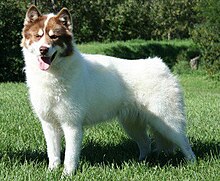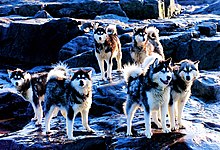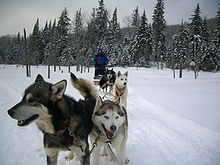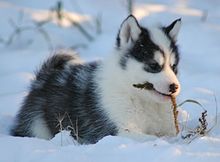This is an old revision of this page, as edited by Varlaam (talk | contribs) at 22:44, 11 March 2012. The present address (URL) is a permanent link to this revision, which may differ significantly from the current revision.
Revision as of 22:44, 11 March 2012 by Varlaam (talk | contribs)(diff) ← Previous revision | Latest revision (diff) | Newer revision → (diff) Dog breed| Canadian Eskimo Dog | |||||||||||||||||||||||||
|---|---|---|---|---|---|---|---|---|---|---|---|---|---|---|---|---|---|---|---|---|---|---|---|---|---|
 | |||||||||||||||||||||||||
| Other names | Qimmiq Canadian Inuit Dog Inuit (sled) dog C. familiaris borealis Esquimaux Dog (obsolete) Exquimaux Husky (obsolete) Kingmik | ||||||||||||||||||||||||
| Origin | Canada | ||||||||||||||||||||||||
| |||||||||||||||||||||||||
| Notes | The UKC does not have an official breed standard | ||||||||||||||||||||||||
| Dog (domestic dog) | |||||||||||||||||||||||||
The Canadian Eskimo Dog is an Arctic breed of dog (Canis lupus familiaris), which is often considered to be North America’s oldest and rarest remaining purebred indigenous domestic canine. Other names include Qimmiq (Inuit for "dog"). Although once used as the preferred method of transportation by Inuit in the Canadian Arctic, traditional working dog teams became increasingly rare in the North after the 1960s. This is often cited a result of snowmobiles becoming more popular, however it may also be the result of the alleged organized and systematic mass slaughter of Inuit sled dogs in the Eastern Arctic between 1950 and 1970 by the Royal Canadian Mounted Police.
Description
Appearance
The Canadian Eskimo Dog should always be powerfully built, athletic, and imposing in appearance. It should be of "powerful physique giving the impression that he is not built for speed but rather for hard work." As is typical of spitz breeds, it has erect, triangular ears, and a heavily feathered tail that is carried over its back. Males should be distinctly more masculine than females, who are finer boned, smaller, and often have a slightly shorter coat.
Its superficial similarity to wolves was often noted by explorers during the Coppermine Expedition of 1819–1822. They noted that the ears of the Eskimo dogs they encountered were similar to those of American wolves, and their forelegs lacked the black mark above the wrist characteristic of European wolves. The most sure way to distinguish the two species was said to be through the length and posture of the tail, which was shorter and more curved in the dog.
Coat and colour

The coat is very thick and dense, with a soft undercoat and stiff, coarse guard hairs. The Eskimo Dog has a mane of thicker fur around its neck, which is quite impressive in the males and adds an illusion of additional size. This mane is smaller in females. Eskimo Dogs can be almost any colour, and no one colour or colour pattern should dominate. Solid white dogs are often seen, as well as white dogs with patches of another colour on the head or both body and head. Solid liver or black coloured dogs are common as well. Many of the solid coloured dogs have white mask-like markings on the face, sometimes with spots over the eyes. Others might have white socks and nose stripes with no eye spots or mask.
Size
There is significant variance in size among Canadian Eskimo Dogs, and the weight and height should be proportionate to each other. The average size of Canadian Eskimo Dogs is:
- Height (at the withers)
- Males: 58 – 70 cm (23 – 28 in)
- Females: 50 – 60 cm (19½ - 23½ in)
- Weight
- Males: 30 - 40 kg (66 - 88 lb)
- Females: 18 – 30 kg (40 - 66 lb)
Temperament
The Canadian Eskimo Dog's temperament reflects its original work and environment. It is loyal, tough, brave, intelligent, and alert. It is affectionate and gentle, and develops a deep bond with its owner and is intensely loyal. When used as sled dogs, they were often required to forage and hunt for their own food. Consequently, many Canadian Eskimo Dogs have stronger prey drive than some other breeds. Owing to their original environment, they take pure delight in cold weather, often preferring to sleep outside in cold climates. Like most spitz breeds they can be very vocal.
Care and training
Canadian Eskimo Dogs need a very large amount of exercise. They cannot just be walked, they need higher intensity work, requiring more exercise than many dog owners can give. This need for work and stimulation also makes them well suited for dog sports, such as carting, mushing, and skijoring. They are very trainable and submissive, unlike many spitz breeds, as well as intelligent. The Canadian Eskimo Dog is best kept in a cold climate, and is prone to heatstroke. Its coat is fairly easy to care for most times of the year, needing brushing only one or two times a week. However when it sheds (which happens once a year) it will need grooming every day.
Historically, Inuit would put their dogs to the harness as soon as they could walk, and would acquire the habit of pulling sledges in their attempts to break free. At the age of two months, the pups would be placed with adult dogs. Sometimes, ten pups would be put under the lead of an older animal, coupled with frequent beatings from their masters, which would educate the pups.
History


The Canadian Eskimo Dog is known to have been resident in the Arctic for at least 4000 years. The Canadian Eskimo Dog was first bred by the Thule people, while research has shown that it is related to the Greenland dog, with very little significant genetic differences. It is sometimes considered the same breed by authorities, although the Greenland dog can be criticized for lacking any proper breeding program, questioning its validity as a pure breed. Inuit never considered the dog as part of the animal kingdom (uumajuit), but merely as a tool for human existence. It was, and still is (to a very limited extent), used by the Canadian Inuit as multi-purpose dogs, often put to work hunting seals and other Arctic game, and hauling supplies and people. Explorers noted that the dogs were capable of tracking a seal hole from a great distance, and were occasionally used to hunt polar bears. The dogs were reported to be so enthusiastic in hunting bears that, sometimes, their handlers shouted "nennook" (their name for the bear) to encourage them when pulling sledges. The dogs however would not pursue wolves, and would howl fearfully at their approach. Frozen dog urine was used by Inuit as a medicine, and their fur was more prized than that of wolves, due to its greater resistance to wear. In times of famine, the dogs would be used as an emergency food source. Though once assumed to be a tamed wolf or wolf-dog hybrid by explorers, including Charles Darwin due to similarities in appearance and vocalisations, genetic testing has shown that the Eskimo dog has no recent wolf ancestry.
Decline

There is some debate surrounding the decline of the breed. Often the introduction of the snowmobile is cited as the main contributing factor. In the 19th century and early 20th century this breed was in demand for polar expeditions. When snowmobiles came into use, the population numbers started rapidly declining, because snowmobiles are faster and need less care. In the 1920s there were approximately 20,000 dogs living in the Canadian Arctic, and the breed had been accepted for showing by both the AKC and CKC; however, in 1959 the AKC dropped the breed from its registry because of extremely low numbers. Inuit communities have gone on record for blaming the breed's decline on mass killings that occurred during the 1950s to 1970s. Many claim that the RCMP and other persons in authority killed Inuit sled dogs systematically and determinedly. It is proposed this was done to disrupt Inuit culture and way of life. Though there there is no major consensus, by 1963 there was supposedly only one dog registered with the CKC, and when this dog died there were still no others registered. The decline in dog population and allegations against the RCMP by Inuit is documented in the 2010 National Film Board of Canada film Qimmit: A Clash of Two Truths.
Resurgence
It probably would have gone extinct if not for the Eskimo Dog Research Foundation (EDRF) and Brian Ladoon (The Canadian Eskimo Dog Foundation). The EDRF was founded in 1972 by William Carpenter and John McGrath and was largely funded by the Canadian Government and the Northwest Territories, with some support from the CKC. The EDRF purchased dogs from the small (about 200 dogs) population remaining in the Canadian Arctic from remote Inuit camps on Baffin Island, Boothia Peninsula, and Melville Peninsula. The EDRF then began breeding dogs in order to increase numbers. Brian Ladoon also bought dogs in the 70's from the Northern Communities of Canada and started breeding after being given the mission of saving them by the Bishop of the North (Bishop Robideaux). Brian Ladoon switched from Malamutes and Huskies to the CED and after breeding for 30 years still has the largest genetic stock colony of Canadian Eskimo Dogs in the world. The documentary "The Last Dogs of Winter" (2011) tells Brian Ladoons story.
The Canadian Eskimo Dog is still very rare; however, it is becoming more popular in Arctic tourism, with an increasing number of sled dog teams that entertain tourists. Additionally, commercial polar bear hunts must be conducted by 'traditional' methods in the Northwest Territories and Nunavut, which is by dog team. This is required partly for safety reasons; the working dog can better sense when a polar bear is around, whereas the sound of a skidoo motor masks any sign of a polar bear. On May 1, 2000, the Canadian territory of Nunavut officially adopted the "Canadian Inuit Dog" as the animal symbol of the territory, thus sealing the name of their traditional dog, qimmiq in the Inuktitut language. This was recorded in the Hansard 01/05/2000 of the Legislative Assembly of the Nunavut Territory.
See also
References

- http://www.qimmiq.ca/ Retrieved May 10, 2008.
- http://www.dogsledding.com/about_us/our_dogs.html Retrieved January 18, 2008
- http://www.inuitsleddoginternational.com/ Retrieved May 10, 2008
- ^ Legislative assembly of Nunavut: The Canadian Inuit Dog (CANIS FAMILIARIS BOREALIS) - Official Animal of Nunavut
- http://www.webcitation.org/query?url=http://www.geocities.com/cherowolf.geo/neda.html&date=2009-10-25+17:12:41 Retrieved May 10, 2008.
- ^ New Zealand Kennel Club: Canadian Eskimo Dog breed standard Retrieved June 23, 2007
- http://www.smithsonianmag.com/travel/10012521.html Retrieved January 17, 2008
- ^ http://polarbearworld.com/aboutdog.htm Retrieved January 17, 2007
- ^ Bell, Jim (December 8, 2006). "RCMP: Dogs killed for health and safety". Nunatsiaq News. Retrieved 4 January 2011.
- QIKIQTANI TRUTH COMMISSION
- Final Report: RCMP Review of Allegations Concerning Inuit Sled Dogs
- ^ Canadian Kennel Club: Canadian Eskimo Dog breed standard. Retrieved April 28, 2007
- ^ Fauna Boreali-americana, Or, The Zoology of the Northern Parts of British America: Containing Descriptions of the Objects of Natural History Collected on the Late Northern Land Expeditions, Under Command of Captain Sir John Franklin, R.N. by John Richardson, William Swainson, William Kirby, published by J. Murray, 1829
- ^ The Kennel Club: Canadian Eskimo Dog breed standard. Retrieved June 23, 2007.
- http://www.paullandry.ca/pdf/Polarcontroversy.pdf Retrieved January 18, 2008
- ^ http://www.arctic.uoguelph.ca/cpl/Traditional/traditional/qimmiq.htm Retrieved January 18, 2008
- http://homepage.mac.com/puggiq/V7N4/V7,N4SameDog.html Retrieved January 18, 2008
- ^ The Menageries: Quadrupeds, Described and Drawn from Living Subjects by James Rennie, Society for the Diffusion of Useful Knowledge (Great Britain). Contributor Charles Knight, William Clowes, Longman, Rees, Orme, Brown, and Green, Oliver & Boyd, published by Charles Knight, 1829
- Coppinger, Ray (2001). Dogs: a Startling New Understanding of Canine Origin, Behavior and Evolution. p. 352. ISBN 0684855305.
- The Variation of Animals and Plants Under Domestication Part One by Charles Darwin, 1885
- Inuit Sled Dog International
- http://www.cbc.ca/sevenwonders/more_wonders_animals.html Retrieved January 18, 2008
- "Qimmit: A Clash of Two Truths". Documentary film. National Film Board of Canada. Retrieved 2 November 2011.
{{cite web}}: Unknown parameter|coauthors=ignored (|author=suggested) (help) - http://www.nunavuttourism.com/experience/index.aspx?l=0,2,3,13
- http://outdoorcanada.ca/11285/hunting/big-game/hunting-adventure-polar-bear
External links
- Canadian Eskimo Dog Club of Canada
- Canadian Eskimo Dog Club of Great Britain
- Canadian Inuit/Eskimo Dog Network
- Inuit Sled Dog International
| Dogs originating in Canada | ||
|---|---|---|
| Extant | ||
| Extinct | ||